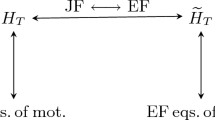Abstract
We identify the fiber-bundle-with-connection structure that underlies the Lanczos H-tensor formulation of Riemannian geometrical structure. We consider linear connections to be type (1,2) affine tensor fields, and we sketch the structure of the appropriate fiber bundle that is needed to describe the differential geometry of such affine tensors, namely the affine frame bundleA 21 M with structure groupA 21 (4) =GL(4) ⓈT 21 ℝ4 over spacetimeM. Generalized affine connections on this bundle are in 1-1 correspondence with pairs(Γ, K) onM, where thegl(4)-componentΓ denotes a linear connection and the T 21 ℝ4-componentK is a type (1,3) tensor field onM. We show that the Lanczos H-tensor arises from a gauge fixing condition on this geometrical structure. The resulting translation gauge, theLanczos gauge, is invariant under the transformations found earlier by Lanczos. The other Lanczos variablesQ μmandq are constructed in terms of the translational component of the generalized affine connection in the Lanczos gauge. To complete the geometric reformulation we reconstruct the Lanczos Lagrangian completely in terms of affine invariant quantities. The essential field equations derived from ourA 21 (4)-invariant Lagrangian are the Bianchi and Bach-Lanczos identities for four-dimensional Riemannian geometry.
Similar content being viewed by others
References
Weyl, H. (1918).Math. Zeit. 2, 384.
Géhéniau, J. and Debever, R. (1956).Bull. Acad. Roy. Belg., CL des SC 42, 114,252,313,608.
Lanczos, C. (1962).Rev. Mod. Phys. 34, 379.
Lanczos, C. (1938).Ann. Math. 39, 842.
Nash, C. and Sen S. (1983).Topology and Geometry for Physicists (Academic Press, London, New York).
Takeno, H. (1964).Tensor 15, 103.
Novello, M. and Velloso, A. (1987).Gen. Rel. Grav. 19, 1251.
Atkins, W. K. and Davis, W. R. (1980).Il Nuovo Cimento 59B, 116.
Bampi, E. and Caviglia, G. (1983).Gen. Rel Grav. 15, 375.
Roberts, M. D. (1989).Mod. Phys. Lett. 4A, 2739.
Bach, R. (1921).Math. Zeit. 9, 110.
Norris, L. K. (1985).Phys. Rev. D 31, 3090.
Yang, C. N. (1974).Phy. Rev. Lett. 33, 445.
Dodson, C. T. J. and Poston, T. (1977).Tensor Geometry (Pitman, London).
Kobayashi, S., and Nomizu, K. (1963).Foundations of Differential Geometry (Interscience, New York), vol. 1.
Chilton, J. H. and Norris, L. K. (1992).Int. J Theor. Phys. 31, 1267.
Kheyfets, A., and Norris, L. K. (1988).Int. J. Theor. Phys. 27, 159.
Norris, L. K. (1991).Int. J. Theor. Phys. 30, 1127.
Fairchild, E. E. Jr. (1976).Phy. Rev. D 14, 384.
Synge, J. L. (1960).Relativity: The General Theory (North-Holland, Amsterdam).
Author information
Authors and Affiliations
Rights and permissions
About this article
Cite this article
Hammon, K.S., Norris, L.K. The affine geometry of the Lanczos H-tensor formalism. Gen Relat Gravit 25, 55–80 (1993). https://doi.org/10.1007/BF00756929
Received:
Issue Date:
DOI: https://doi.org/10.1007/BF00756929




